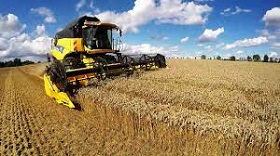Agriculture, Analytics, Estonia, Markets and Companies
International Internet Magazine. Baltic States news & analytics
Wednesday, 24.04.2024, 03:51
Chamber of agriculture: Estonia's cereal yield to be 40% lower this year
 Print version
Print version |
|---|
"Nine in ten producers said that the cereal yield for their company this year will be more than 30 percent lower. Yields vary very much -- depending on crop and region, the per-hectare yield varied from half a ton to 5-6 tons. Compared with last year we are in for a big reduction in the yields of almost all crops, only the situation of legumes is somewhat better," Roomet Sormus, chairman of the board of the Chamber of Agriculture and Commerce, said commenting on the findings of a survey taken by the chamber.
Spring barley, the cereal grown on the biggest area in Estonia, is estimated to show yields about 45% lower than last year. Spring wheat, the second most common crop, is also estimated to see yields smaller by one-third.
The total harvest of cereals, legumes and oleaginous plants in Estonia in 2018 is expected to total slightly over one million tons, one-thrid less than in 2017.
Of the dairy cow, beef animal and sheep raisers interviewed about one in three had less than half of the necessary amount of grass-based feed ready as on Aug. 14 and a very big portion still had to produce at least a quarter of the necessary amount.
While cattle farmers lay their hopes on the third mow, 28% nevertheless predict that they will be unable to stock up enough by the end of the season and a big portion of the required amount will have to be bought. For pig and poultry farmers the main concern is the big rise in the price of grain and its availability on the domestic market.
Of he respondents 205 reported having lost a big portion of the new grassland sown this year, with altogether 6,382 hectares of such land requiring to be resown. Considering the percentage that respondents in the survey make up of the total number of agricultural producers, the area of grassland affected by drought probably is several times bigger, the chamber said.
The Chamber of Agriculture and Commerce interviewed 644 farming businesses from Aug. 14 to 24 to get a more precise picture of the scope of the damage caused by drought. Of the interviewed businesses 331 were regular producers and 313 organic producers. The total land area farmed by the businesses is 213,477 hectares, of which area under non-organic farming makes up 73% and area under organic farming 27%. Of the respondents 104 engaged in dairy cow raising, 219 in beef cattle raising, and 81 in sheep and goat raising.
The European Commission is awaiting more precise data on the scale of the drought damage from the member states by Aug. 31 to decide about possible additional measures to alleviate the plight of farmers.








 «The Baltic Course» Is Sold and Stays in Business!
«The Baltic Course» Is Sold and Stays in Business!

